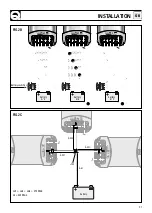
22
INSTALLATION
GB
SINGLE BATTERY CHARGER
The positive terminal of the battery or of the group of batteries must be connected to one of the positive
terminals of the battery charger. The negative terminal of the battery or of the group of batteries must be
connected to the negative terminal of the battery charger. To make the connections use the cable terminals
supplied with the equipment.
BATTERY CHARGER IN PARALLEL
The "MASTER" positive terminal is to be connected to junction "JM"; junction "JM" is to be connected to the
positive terminal of the battery or group of batteries. (fig. 2B).
The "SLAVE A" positive terminal of the battery charger is to be connected to junction "JSA"; junction "JSA"
is to be connected to the positive terminal of the battery or group of batteries. (fig. 2B).
The "SLAVE B" positive terminal of the battery charger is to be connected to junction "JSB"; junction "JSB"
is to be connected to the positive terminal of the battery or group of batteries. (fig. 2B).
The negative terminal of the battery charger is to be connected to junction "JCN"; junction "JCN" is to be
connected to the negative terminal of the battery or group of batteries (fig. 2B).
The lengths of cables that run from the terminals of the battery chargers to the junctions must be the same
and never exceed 2 m (fig. 2C ).
If the installation has only one or two groups of batteries, always connect the output marked “MASTER”.
This is the main outlet of the battery charger.
If the “MASTER” is not connected, the battery charger may supply an output lower voltage than rated and
therefore less power.
It is advisable to connect the group of batteries which are used more often (typically the service group) to
the MASTER output terminal.
The positive output terminals that are not used must be kept free (do not bridge the terminals).
WARNING:
the use of inadequate size cables and the incorrect connection of terminals or electri-
cal joints may result in dangerous overheating of the connecting terminals or cables.
BATTERIES
To access the output terminals it is necessary to remove the cover by loosening the two screws which hold
it on (fig. 1 part A).
Before making the connections to the cables from the battery, loosen or remove the cable clamps by loo-
sening the screws which fix it to the base (fig.1 part B).
WARNING:
during charge, batteries can generate explosive gases, therefore avoid sparks or naked
flames. Provide adequate ventilation to the battery area whilst charging.
WARNING:
before connecting the batteries check the terminals of the cables from the battery.
Reversing the terminals, could seriously damage the battery charger even if protected by fuses.
















































